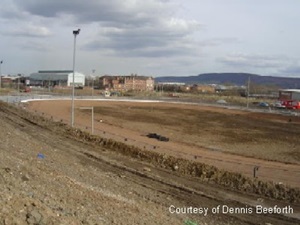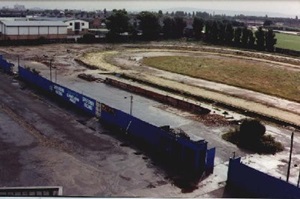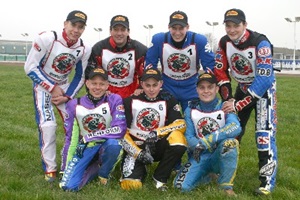
| Home | Contact Us | Articles |
| Books - DVDs | Stadia Pix | Programme Generator |
The Bears Are Back!
 |
Tonight (Thursday 13th April 2006) is a significant milestone in speedway history. For the first time in almost 10 years the Bears will race into action around their own circuit. The purpose built track at the South Tees Motorcycle Park sees the newly christened Redcar Bears do battle with the Tigers from Sheffield.
Although the Redcar moniker is new, this is not a club without a history. These Bears are, in reality, a revival of the Middlesbrough Bears that we've missed so badly since 1996.
We last saw the Bears in the dying days of the original Premier League. They had bravely battled through two seasons with low crowds and a weak side. It became apparent mid-season that the Bears were doomed, their Cleveland Park home had caught the eyes of developers that wanted to extend the neighbouring college. The club limped on until the end of the season and bowed out with an emotional final meeting that attracted the highest gate of the season. This brought to an end an unbroken spell of 29 seasons of racing.
A Middlesbrough (or Teeside) team were ever-present members of the National League and boasted many star names in their rather up and down existence. Throughout the seventies names like Tom Leadbitter, Bruce Forrester and Dave Durham entertained the thousands that flocked to Cleveland Park.
The club's glory years were undoubtedly the 1980's when they were consistently one of the top sides in the league. The side featured riders such as Martin Dixon, Geoff Pusey, Mark Courtney and 'Mr Middlesbrough' himself, Steve Wilcock. All of these were present in the legendary 1981 side that captured the National League title.
The side came close again in 1985 when they narrowly missed out to Ellesmere Port. This was the debut season of one Gary Havelock. 'Havvy' was an immediate success and would lift the World Championship only 7 years later. Havelock will return to his roots in 2006 as the first captain of the Redcar Bears. His presence alone lends the club instant credibility and he will once again become a hero to the people of Cleveland.
After that year things were never quite the same. A fire destroyed the main grandstand and the fans began to drift away. The late eighties saw riders like Daz Sumner, Mark Fiora and Jamie Luckhurst turning out in the red and white. The team was generally competitive and the fans were enthusiastic travellers.
The nineties started well for the Bears. They were title challengers in the 1990 season, their strong side included Dave Cheshire, Rod Hunter and Paul Bentley. The next few years saw great change in the side. Steve Regeling was an excellent number one and riders like Brett Saunders, Paul Whittaker and Jens Rasmussen passed through. The club received a boost in 1994 when Paul Bentley, back on loan from Coventry, lifted the Division 2 Riders Championship. This was the last trophy that the Bears won.
 |
The years of the 'one big league' (1995 and 1996) were a struggle for the Bears. It proved difficult to attract top names to the North East and the club struggled along with a weak side. Undisputed number one was Shane Parker. Parker found a new maturity at Cleveland Park and established himself as a genuine heatleader. Parker's team mates included solid journeymen like David Walsh, Jesper Olsen and Scott Robson, promising youngsters such as Mike Smith and low quality imports like Martin Petarca.
By the end of 1996 Middlesbrough Speedway was no more. Promoter Malcolm Wright moved on to Sheffield, the riders found new clubs and the stadium was demolished to make way for the impending redevelopment. Only the fans and their memories remained.
The redevelopment never happened and the good folk of Middlesbrough were left without a Speedway team. The timing of the closure was particularly galling as the current Premier League was formed in 1997. This new league, with a heavy northern emphasis, was based on sensible costings and would have been perfect for Middlesbrough. The gates they were attracting in the original Premier League would have more than covered the new operating costs and the club would have thrived. The Premier League has been all the poorer for their absence and their return is a real shot in the arm for a competition that has lost Hull, Exeter and Reading from its 2005 membership.
 |
In recent years a Middlesbrough Bears team has competed in junior challenge meetings at venues around the country. Steve Harland and Jason Pipe were the individuals responsible for running the team and they deserve great credit for pushing the Middlesbrough name back into the speedway spotlight. Both men were realistic enough to know that they didn't have the finance, experience or contacts to establish a new venue. Instead they concentrated on providing a focal point for like-minded former fans and in keeping the spirit of the club alive. Steve and Jason have now been appointed to support roles within the new club organisation.
Chris Van Straatten, former BSPA chairman and long-time Wolves supremo, is the man who has bankrolled the creation of the new track and cut through the red-tape that inevitably surrounds the construction of any speedway stadium. His trusty lieutenant is Gareth Rogers, an experienced promoter in his own right and a real speedway enthusiast. Between the two of them they have: discovered a venue; obtained planning permission; overseen the build of a track; been accepted for Premier League membership and signed-up a talented squad of riders to wear the colours. Not bad going for little more than a few months work.
Facilities are presently basic at the new stadium, but the track, constructed by former Australian international Glynn Taylor, should be terrific. Taylor was given a free hand in the design of the track and he was unrestricted by the greyhound circuits, lighting poles and football pitches that pre-determine the shape of many of our circuits.
Initial estimates suggest that around 3000 fans may flock to tonight's opening meeting. That would be a healthy opening crowd and I'm sure the promotion would be happy with regular gates of around half of that number. Experience shows that new or revived tracks often attract very healthy crowds in the first year and that crowds tend to tail-off in future seasons. Redcar will hope that they can buck that trend and the ingredients for a successful club - decent track, sensible promotion, good catchment area - seem to be in place.
In recent years we've featured articles on the site welcoming back Wimbledon and Weymouth. Neither of those clubs were able to last the distance, we're confident that the same fate doesn't await the Bears. Welcome Back!
This article was first published on 13th April 2006

"It's great to hear that another club has been reborn rather than closed. Good luck for the future. Being an Arena Essex fan I was pleased to hear that Havvy has got a new goal to fulfill. Best of luck to you all. "